Toyota Company: International Strategy and PESTLE Analysis Report
VerifiedAdded on 2022/01/19
|18
|3047
|429
Presentation
AI Summary
This presentation provides an in-depth analysis of Toyota's international strategy, evaluating contemporary drivers of change and their impact on the company's future. The presentation begins with an introduction and a brief history of Toyota, including its mission, vision, and values. It then delves into the company's long-term objectives and financial position, including balance sheets, cash flows, and income statements. The core of the presentation focuses on the general state of the automotive industry, market expansion strategies, and the application of PESTLE analysis to understand the political, economic, social, technological, ecological, and legal factors affecting Toyota's business. The analysis highlights opportunities such as market expansion, product development, and strategic partnerships. The presentation concludes by emphasizing Toyota's commitment to sustainability and its ability to adapt to the changing global market. This comprehensive overview helps students understand the complexities of international business strategy within a leading automotive company.
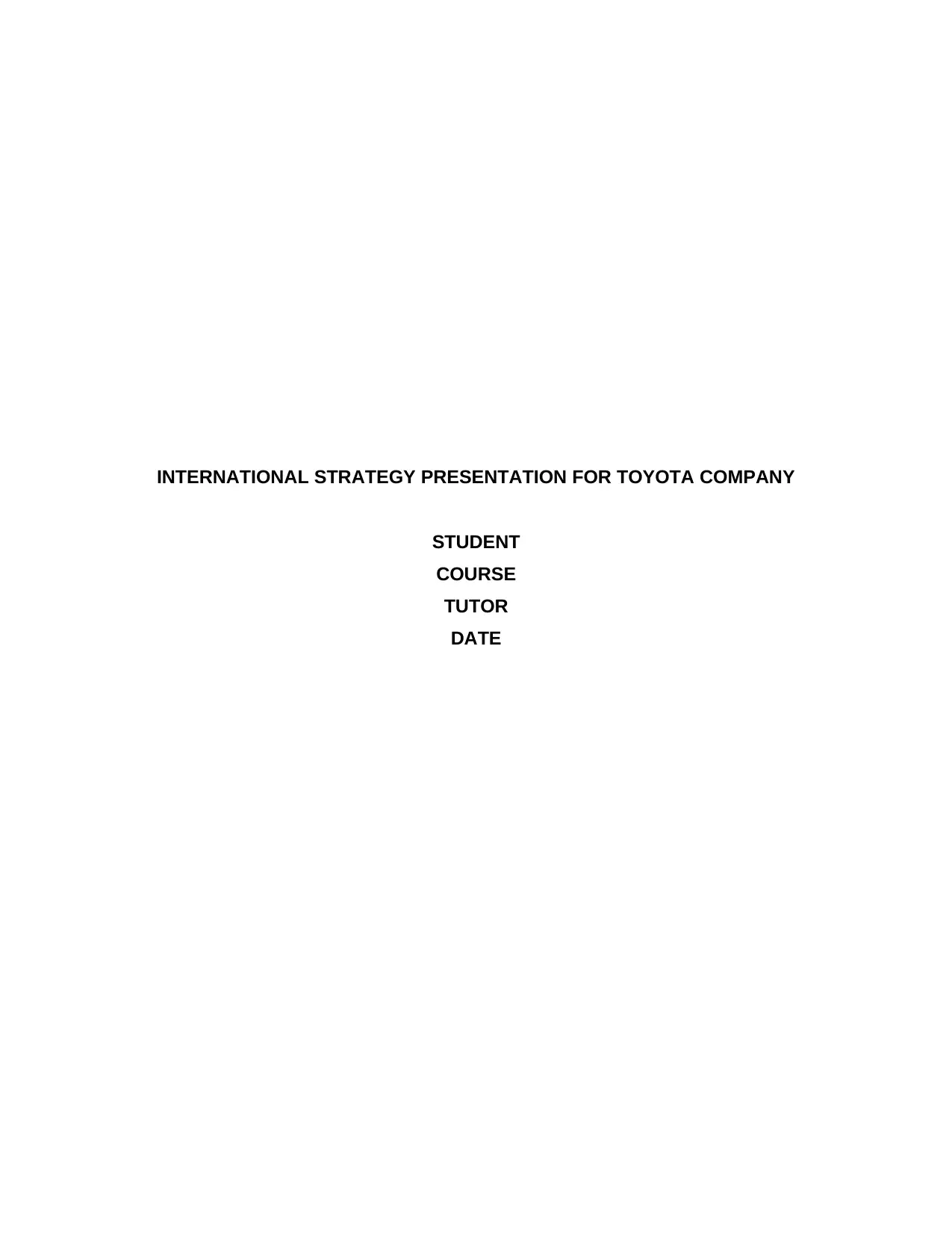
INTERNATIONAL STRATEGY PRESENTATION FOR TOYOTA COMPANY
STUDENT
COURSE
TUTOR
DATE
STUDENT
COURSE
TUTOR
DATE
Paraphrase This Document
Need a fresh take? Get an instant paraphrase of this document with our AI Paraphraser


⊘ This is a preview!⊘
Do you want full access?
Subscribe today to unlock all pages.

Trusted by 1+ million students worldwide
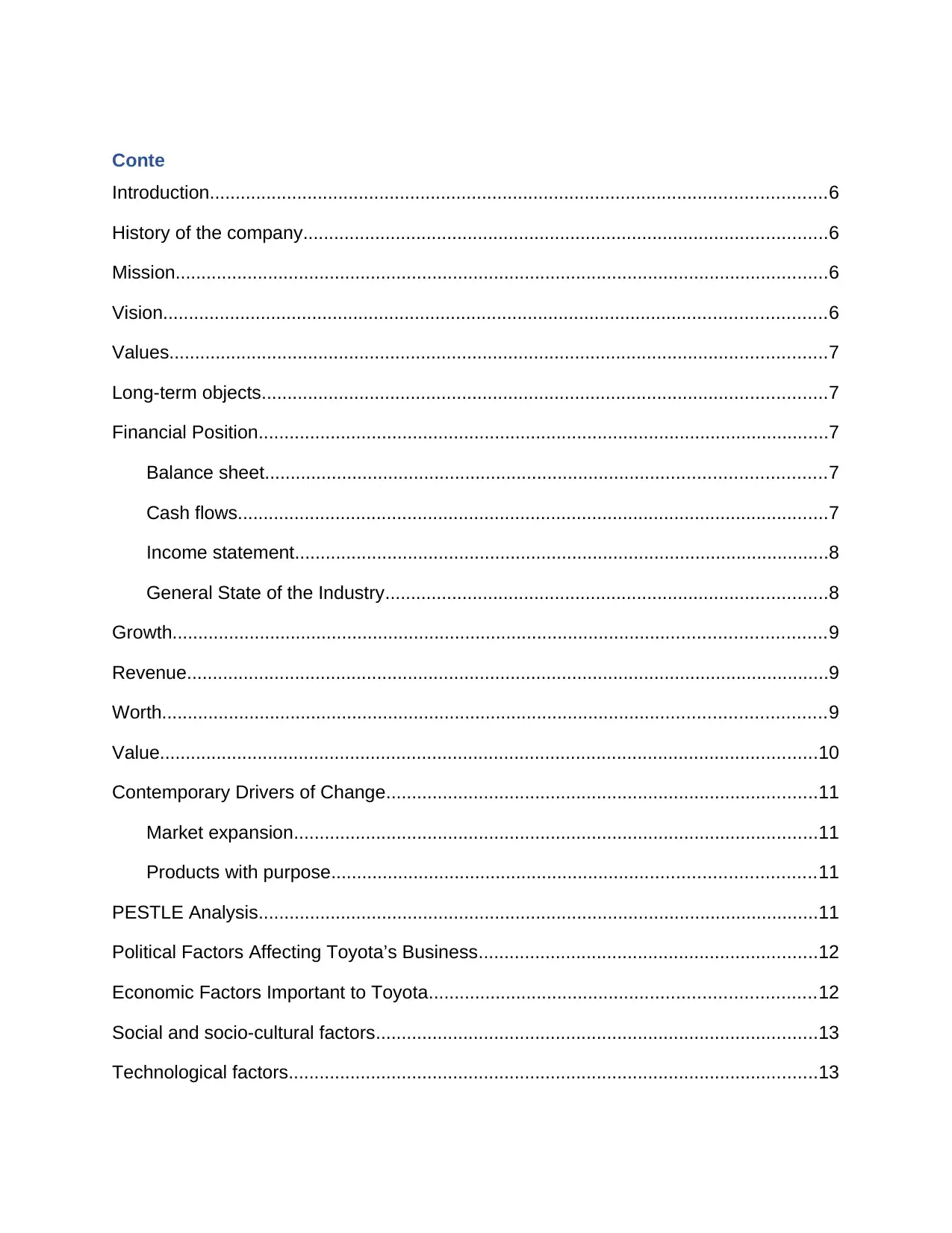
Conte
Introduction........................................................................................................................6
History of the company......................................................................................................6
Mission...............................................................................................................................6
Vision.................................................................................................................................6
Values................................................................................................................................7
Long-term objects..............................................................................................................7
Financial Position...............................................................................................................7
Balance sheet.............................................................................................................7
Cash flows...................................................................................................................7
Income statement........................................................................................................8
General State of the Industry......................................................................................8
Growth...............................................................................................................................9
Revenue.............................................................................................................................9
Worth.................................................................................................................................9
Value................................................................................................................................10
Contemporary Drivers of Change....................................................................................11
Market expansion......................................................................................................11
Products with purpose..............................................................................................11
PESTLE Analysis.............................................................................................................11
Political Factors Affecting Toyota’s Business..................................................................12
Economic Factors Important to Toyota...........................................................................12
Social and socio-cultural factors......................................................................................13
Technological factors.......................................................................................................13
Introduction........................................................................................................................6
History of the company......................................................................................................6
Mission...............................................................................................................................6
Vision.................................................................................................................................6
Values................................................................................................................................7
Long-term objects..............................................................................................................7
Financial Position...............................................................................................................7
Balance sheet.............................................................................................................7
Cash flows...................................................................................................................7
Income statement........................................................................................................8
General State of the Industry......................................................................................8
Growth...............................................................................................................................9
Revenue.............................................................................................................................9
Worth.................................................................................................................................9
Value................................................................................................................................10
Contemporary Drivers of Change....................................................................................11
Market expansion......................................................................................................11
Products with purpose..............................................................................................11
PESTLE Analysis.............................................................................................................11
Political Factors Affecting Toyota’s Business..................................................................12
Economic Factors Important to Toyota...........................................................................12
Social and socio-cultural factors......................................................................................13
Technological factors.......................................................................................................13
Paraphrase This Document
Need a fresh take? Get an instant paraphrase of this document with our AI Paraphraser

Ecological/Environmental Factors...................................................................................14
Legal Factors...................................................................................................................15
References.......................................................................................................................17
Legal Factors...................................................................................................................15
References.......................................................................................................................17
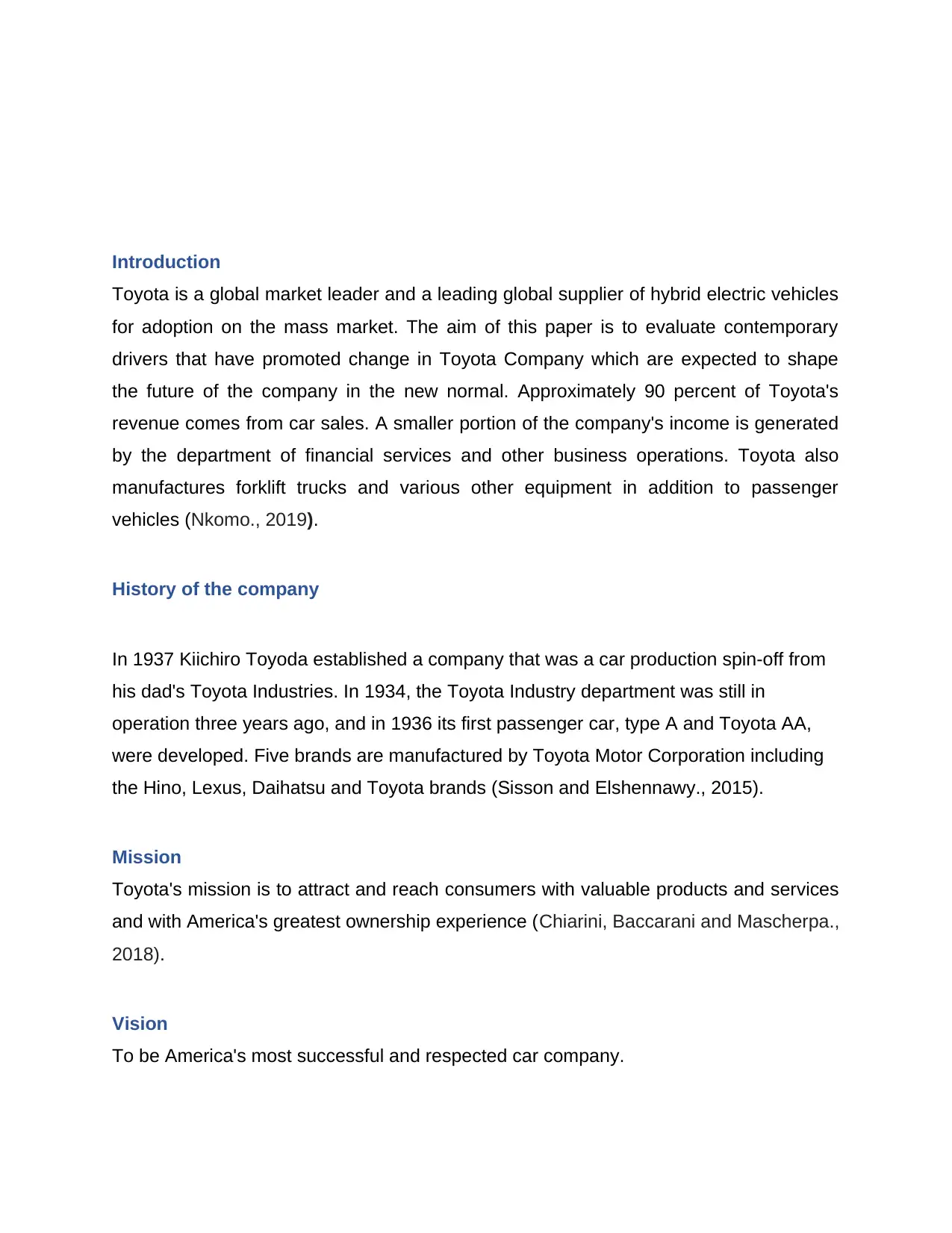
Introduction
Toyota is a global market leader and a leading global supplier of hybrid electric vehicles
for adoption on the mass market. The aim of this paper is to evaluate contemporary
drivers that have promoted change in Toyota Company which are expected to shape
the future of the company in the new normal. Approximately 90 percent of Toyota's
revenue comes from car sales. A smaller portion of the company's income is generated
by the department of financial services and other business operations. Toyota also
manufactures forklift trucks and various other equipment in addition to passenger
vehicles (Nkomo., 2019).
History of the company
In 1937 Kiichiro Toyoda established a company that was a car production spin-off from
his dad's Toyota Industries. In 1934, the Toyota Industry department was still in
operation three years ago, and in 1936 its first passenger car, type A and Toyota AA,
were developed. Five brands are manufactured by Toyota Motor Corporation including
the Hino, Lexus, Daihatsu and Toyota brands (Sisson and Elshennawy., 2015).
Mission
Toyota's mission is to attract and reach consumers with valuable products and services
and with America's greatest ownership experience (Chiarini, Baccarani and Mascherpa.,
2018).
Vision
To be America's most successful and respected car company.
Toyota is a global market leader and a leading global supplier of hybrid electric vehicles
for adoption on the mass market. The aim of this paper is to evaluate contemporary
drivers that have promoted change in Toyota Company which are expected to shape
the future of the company in the new normal. Approximately 90 percent of Toyota's
revenue comes from car sales. A smaller portion of the company's income is generated
by the department of financial services and other business operations. Toyota also
manufactures forklift trucks and various other equipment in addition to passenger
vehicles (Nkomo., 2019).
History of the company
In 1937 Kiichiro Toyoda established a company that was a car production spin-off from
his dad's Toyota Industries. In 1934, the Toyota Industry department was still in
operation three years ago, and in 1936 its first passenger car, type A and Toyota AA,
were developed. Five brands are manufactured by Toyota Motor Corporation including
the Hino, Lexus, Daihatsu and Toyota brands (Sisson and Elshennawy., 2015).
Mission
Toyota's mission is to attract and reach consumers with valuable products and services
and with America's greatest ownership experience (Chiarini, Baccarani and Mascherpa.,
2018).
Vision
To be America's most successful and respected car company.
⊘ This is a preview!⊘
Do you want full access?
Subscribe today to unlock all pages.

Trusted by 1+ million students worldwide
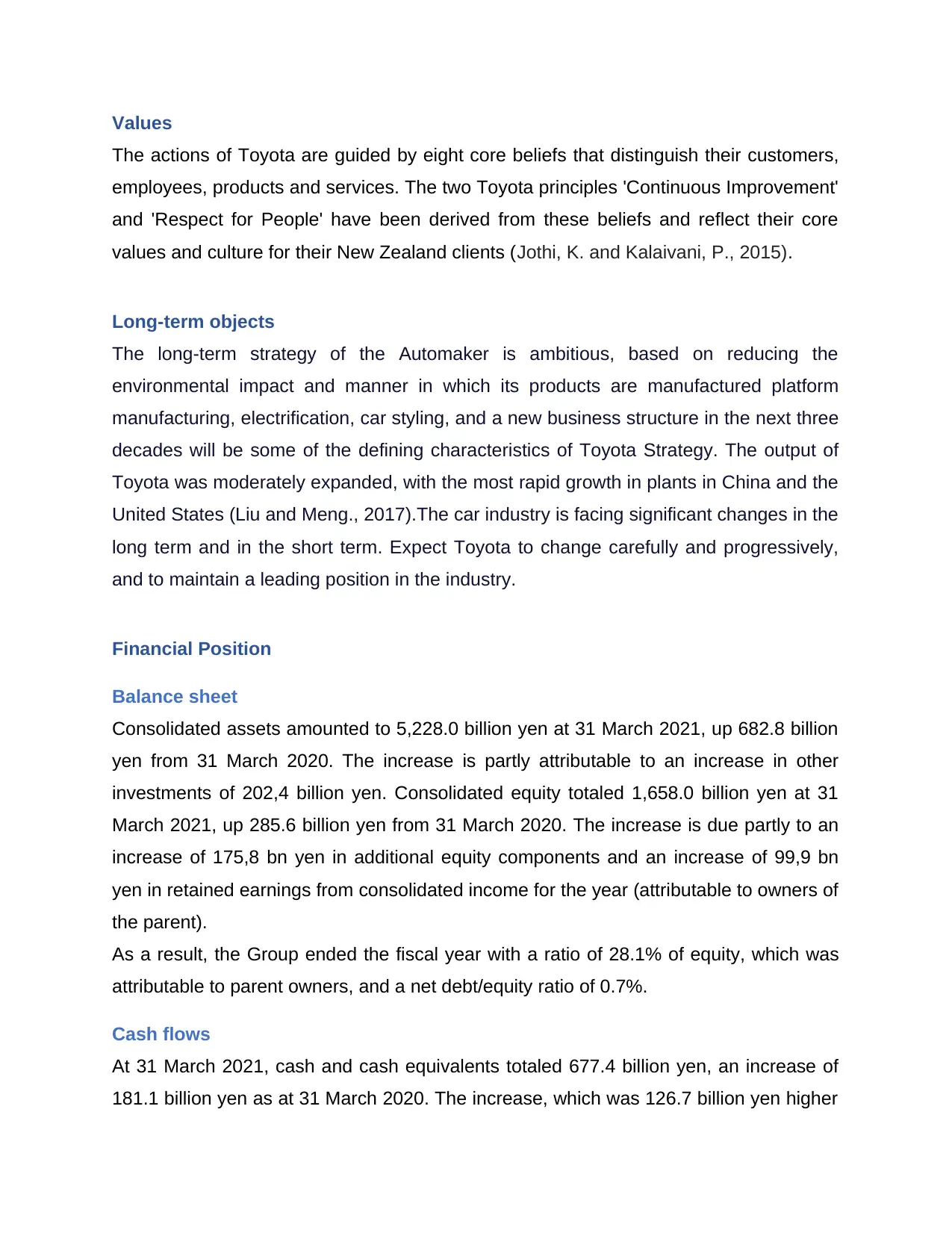
Values
The actions of Toyota are guided by eight core beliefs that distinguish their customers,
employees, products and services. The two Toyota principles 'Continuous Improvement'
and 'Respect for People' have been derived from these beliefs and reflect their core
values and culture for their New Zealand clients (Jothi, K. and Kalaivani, P., 2015).
Long-term objects
The long-term strategy of the Automaker is ambitious, based on reducing the
environmental impact and manner in which its products are manufactured platform
manufacturing, electrification, car styling, and a new business structure in the next three
decades will be some of the defining characteristics of Toyota Strategy. The output of
Toyota was moderately expanded, with the most rapid growth in plants in China and the
United States (Liu and Meng., 2017).The car industry is facing significant changes in the
long term and in the short term. Expect Toyota to change carefully and progressively,
and to maintain a leading position in the industry.
Financial Position
Balance sheet
Consolidated assets amounted to 5,228.0 billion yen at 31 March 2021, up 682.8 billion
yen from 31 March 2020. The increase is partly attributable to an increase in other
investments of 202,4 billion yen. Consolidated equity totaled 1,658.0 billion yen at 31
March 2021, up 285.6 billion yen from 31 March 2020. The increase is due partly to an
increase of 175,8 bn yen in additional equity components and an increase of 99,9 bn
yen in retained earnings from consolidated income for the year (attributable to owners of
the parent).
As a result, the Group ended the fiscal year with a ratio of 28.1% of equity, which was
attributable to parent owners, and a net debt/equity ratio of 0.7%.
Cash flows
At 31 March 2021, cash and cash equivalents totaled 677.4 billion yen, an increase of
181.1 billion yen as at 31 March 2020. The increase, which was 126.7 billion yen higher
The actions of Toyota are guided by eight core beliefs that distinguish their customers,
employees, products and services. The two Toyota principles 'Continuous Improvement'
and 'Respect for People' have been derived from these beliefs and reflect their core
values and culture for their New Zealand clients (Jothi, K. and Kalaivani, P., 2015).
Long-term objects
The long-term strategy of the Automaker is ambitious, based on reducing the
environmental impact and manner in which its products are manufactured platform
manufacturing, electrification, car styling, and a new business structure in the next three
decades will be some of the defining characteristics of Toyota Strategy. The output of
Toyota was moderately expanded, with the most rapid growth in plants in China and the
United States (Liu and Meng., 2017).The car industry is facing significant changes in the
long term and in the short term. Expect Toyota to change carefully and progressively,
and to maintain a leading position in the industry.
Financial Position
Balance sheet
Consolidated assets amounted to 5,228.0 billion yen at 31 March 2021, up 682.8 billion
yen from 31 March 2020. The increase is partly attributable to an increase in other
investments of 202,4 billion yen. Consolidated equity totaled 1,658.0 billion yen at 31
March 2021, up 285.6 billion yen from 31 March 2020. The increase is due partly to an
increase of 175,8 bn yen in additional equity components and an increase of 99,9 bn
yen in retained earnings from consolidated income for the year (attributable to owners of
the parent).
As a result, the Group ended the fiscal year with a ratio of 28.1% of equity, which was
attributable to parent owners, and a net debt/equity ratio of 0.7%.
Cash flows
At 31 March 2021, cash and cash equivalents totaled 677.4 billion yen, an increase of
181.1 billion yen as at 31 March 2020. The increase, which was 126.7 billion yen higher
Paraphrase This Document
Need a fresh take? Get an instant paraphrase of this document with our AI Paraphraser
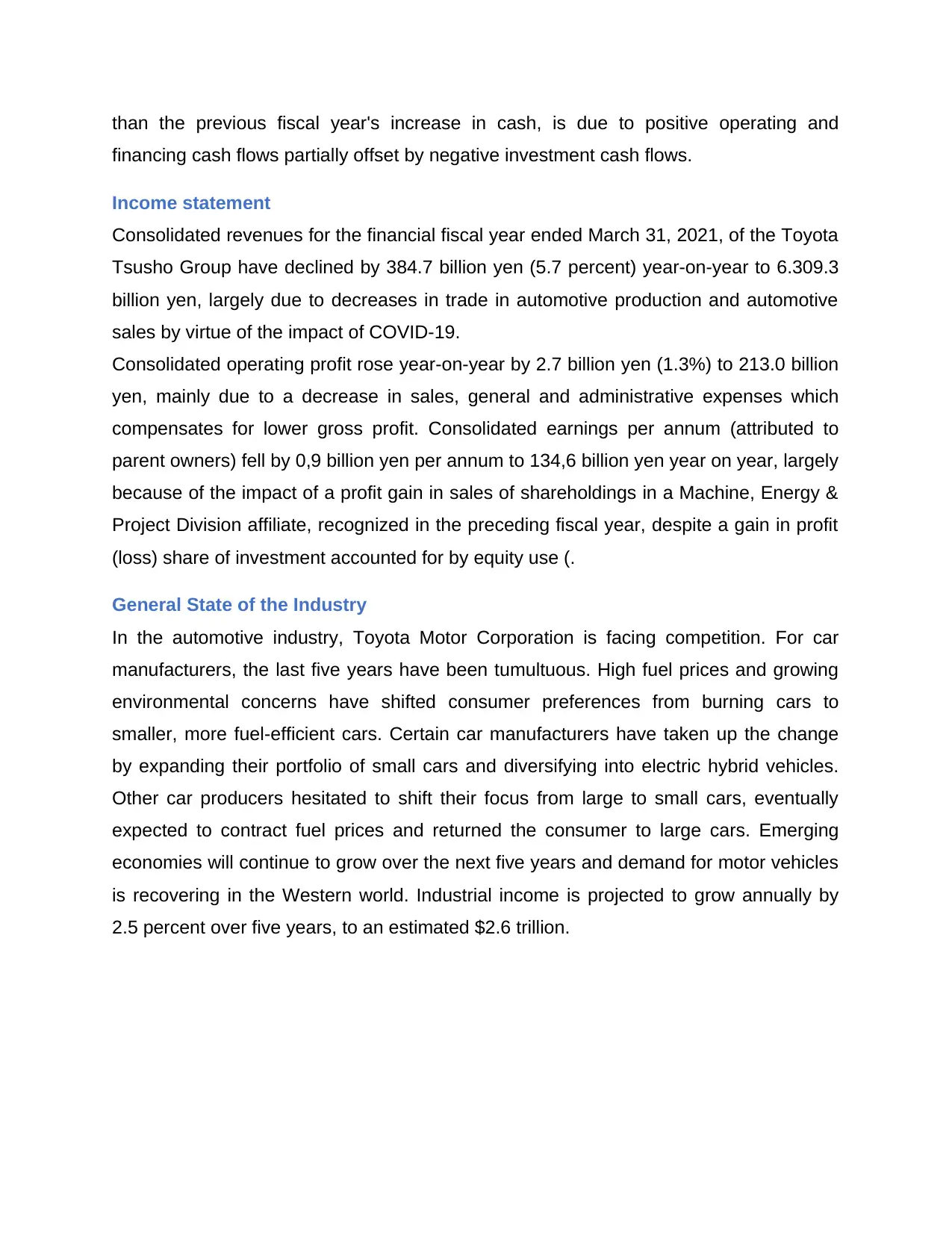
than the previous fiscal year's increase in cash, is due to positive operating and
financing cash flows partially offset by negative investment cash flows.
Income statement
Consolidated revenues for the financial fiscal year ended March 31, 2021, of the Toyota
Tsusho Group have declined by 384.7 billion yen (5.7 percent) year-on-year to 6.309.3
billion yen, largely due to decreases in trade in automotive production and automotive
sales by virtue of the impact of COVID-19.
Consolidated operating profit rose year-on-year by 2.7 billion yen (1.3%) to 213.0 billion
yen, mainly due to a decrease in sales, general and administrative expenses which
compensates for lower gross profit. Consolidated earnings per annum (attributed to
parent owners) fell by 0,9 billion yen per annum to 134,6 billion yen year on year, largely
because of the impact of a profit gain in sales of shareholdings in a Machine, Energy &
Project Division affiliate, recognized in the preceding fiscal year, despite a gain in profit
(loss) share of investment accounted for by equity use (.
General State of the Industry
In the automotive industry, Toyota Motor Corporation is facing competition. For car
manufacturers, the last five years have been tumultuous. High fuel prices and growing
environmental concerns have shifted consumer preferences from burning cars to
smaller, more fuel-efficient cars. Certain car manufacturers have taken up the change
by expanding their portfolio of small cars and diversifying into electric hybrid vehicles.
Other car producers hesitated to shift their focus from large to small cars, eventually
expected to contract fuel prices and returned the consumer to large cars. Emerging
economies will continue to grow over the next five years and demand for motor vehicles
is recovering in the Western world. Industrial income is projected to grow annually by
2.5 percent over five years, to an estimated $2.6 trillion.
financing cash flows partially offset by negative investment cash flows.
Income statement
Consolidated revenues for the financial fiscal year ended March 31, 2021, of the Toyota
Tsusho Group have declined by 384.7 billion yen (5.7 percent) year-on-year to 6.309.3
billion yen, largely due to decreases in trade in automotive production and automotive
sales by virtue of the impact of COVID-19.
Consolidated operating profit rose year-on-year by 2.7 billion yen (1.3%) to 213.0 billion
yen, mainly due to a decrease in sales, general and administrative expenses which
compensates for lower gross profit. Consolidated earnings per annum (attributed to
parent owners) fell by 0,9 billion yen per annum to 134,6 billion yen year on year, largely
because of the impact of a profit gain in sales of shareholdings in a Machine, Energy &
Project Division affiliate, recognized in the preceding fiscal year, despite a gain in profit
(loss) share of investment accounted for by equity use (.
General State of the Industry
In the automotive industry, Toyota Motor Corporation is facing competition. For car
manufacturers, the last five years have been tumultuous. High fuel prices and growing
environmental concerns have shifted consumer preferences from burning cars to
smaller, more fuel-efficient cars. Certain car manufacturers have taken up the change
by expanding their portfolio of small cars and diversifying into electric hybrid vehicles.
Other car producers hesitated to shift their focus from large to small cars, eventually
expected to contract fuel prices and returned the consumer to large cars. Emerging
economies will continue to grow over the next five years and demand for motor vehicles
is recovering in the Western world. Industrial income is projected to grow annually by
2.5 percent over five years, to an estimated $2.6 trillion.
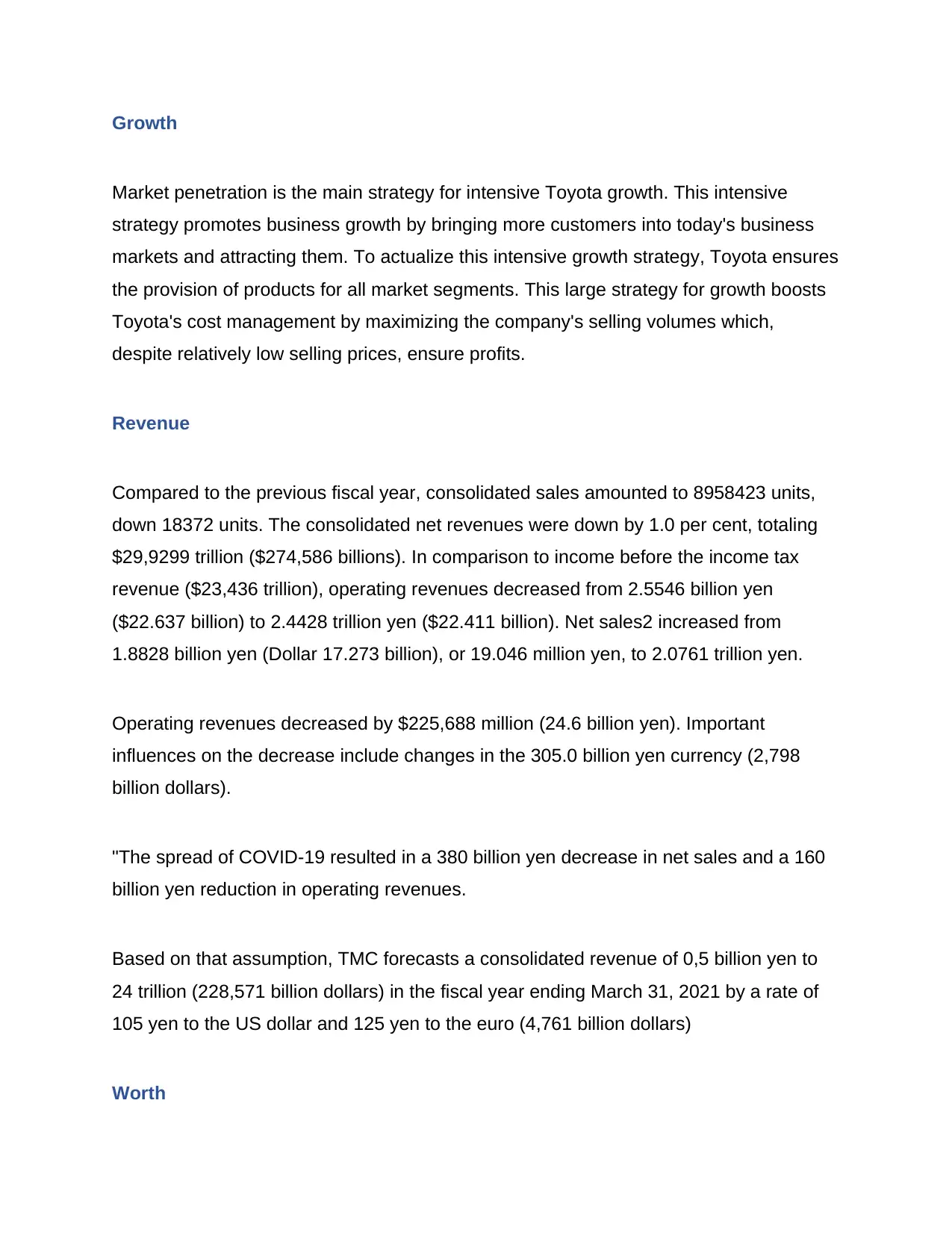
Growth
Market penetration is the main strategy for intensive Toyota growth. This intensive
strategy promotes business growth by bringing more customers into today's business
markets and attracting them. To actualize this intensive growth strategy, Toyota ensures
the provision of products for all market segments. This large strategy for growth boosts
Toyota's cost management by maximizing the company's selling volumes which,
despite relatively low selling prices, ensure profits.
Revenue
Compared to the previous fiscal year, consolidated sales amounted to 8958423 units,
down 18372 units. The consolidated net revenues were down by 1.0 per cent, totaling
$29,9299 trillion ($274,586 billions). In comparison to income before the income tax
revenue ($23,436 trillion), operating revenues decreased from 2.5546 billion yen
($22.637 billion) to 2.4428 trillion yen ($22.411 billion). Net sales2 increased from
1.8828 billion yen (Dollar 17.273 billion), or 19.046 million yen, to 2.0761 trillion yen.
Operating revenues decreased by $225,688 million (24.6 billion yen). Important
influences on the decrease include changes in the 305.0 billion yen currency (2,798
billion dollars).
"The spread of COVID-19 resulted in a 380 billion yen decrease in net sales and a 160
billion yen reduction in operating revenues.
Based on that assumption, TMC forecasts a consolidated revenue of 0,5 billion yen to
24 trillion (228,571 billion dollars) in the fiscal year ending March 31, 2021 by a rate of
105 yen to the US dollar and 125 yen to the euro (4,761 billion dollars)
Worth
Market penetration is the main strategy for intensive Toyota growth. This intensive
strategy promotes business growth by bringing more customers into today's business
markets and attracting them. To actualize this intensive growth strategy, Toyota ensures
the provision of products for all market segments. This large strategy for growth boosts
Toyota's cost management by maximizing the company's selling volumes which,
despite relatively low selling prices, ensure profits.
Revenue
Compared to the previous fiscal year, consolidated sales amounted to 8958423 units,
down 18372 units. The consolidated net revenues were down by 1.0 per cent, totaling
$29,9299 trillion ($274,586 billions). In comparison to income before the income tax
revenue ($23,436 trillion), operating revenues decreased from 2.5546 billion yen
($22.637 billion) to 2.4428 trillion yen ($22.411 billion). Net sales2 increased from
1.8828 billion yen (Dollar 17.273 billion), or 19.046 million yen, to 2.0761 trillion yen.
Operating revenues decreased by $225,688 million (24.6 billion yen). Important
influences on the decrease include changes in the 305.0 billion yen currency (2,798
billion dollars).
"The spread of COVID-19 resulted in a 380 billion yen decrease in net sales and a 160
billion yen reduction in operating revenues.
Based on that assumption, TMC forecasts a consolidated revenue of 0,5 billion yen to
24 trillion (228,571 billion dollars) in the fiscal year ending March 31, 2021 by a rate of
105 yen to the US dollar and 125 yen to the euro (4,761 billion dollars)
Worth
⊘ This is a preview!⊘
Do you want full access?
Subscribe today to unlock all pages.

Trusted by 1+ million students worldwide
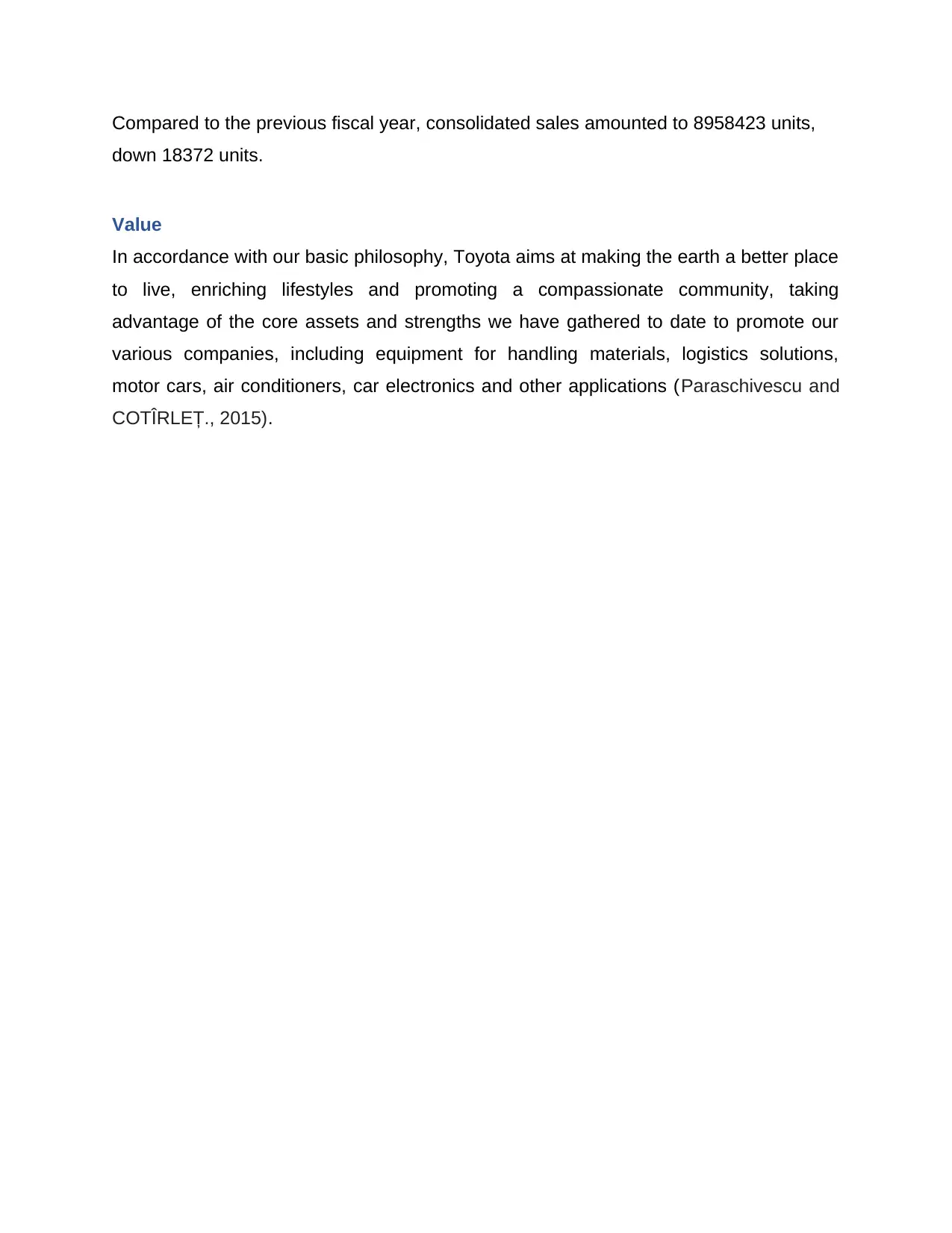
Compared to the previous fiscal year, consolidated sales amounted to 8958423 units,
down 18372 units.
Value
In accordance with our basic philosophy, Toyota aims at making the earth a better place
to live, enriching lifestyles and promoting a compassionate community, taking
advantage of the core assets and strengths we have gathered to date to promote our
various companies, including equipment for handling materials, logistics solutions,
motor cars, air conditioners, car electronics and other applications (Paraschivescu and
COTÎRLEȚ., 2015).
down 18372 units.
Value
In accordance with our basic philosophy, Toyota aims at making the earth a better place
to live, enriching lifestyles and promoting a compassionate community, taking
advantage of the core assets and strengths we have gathered to date to promote our
various companies, including equipment for handling materials, logistics solutions,
motor cars, air conditioners, car electronics and other applications (Paraschivescu and
COTÎRLEȚ., 2015).
Paraphrase This Document
Need a fresh take? Get an instant paraphrase of this document with our AI Paraphraser
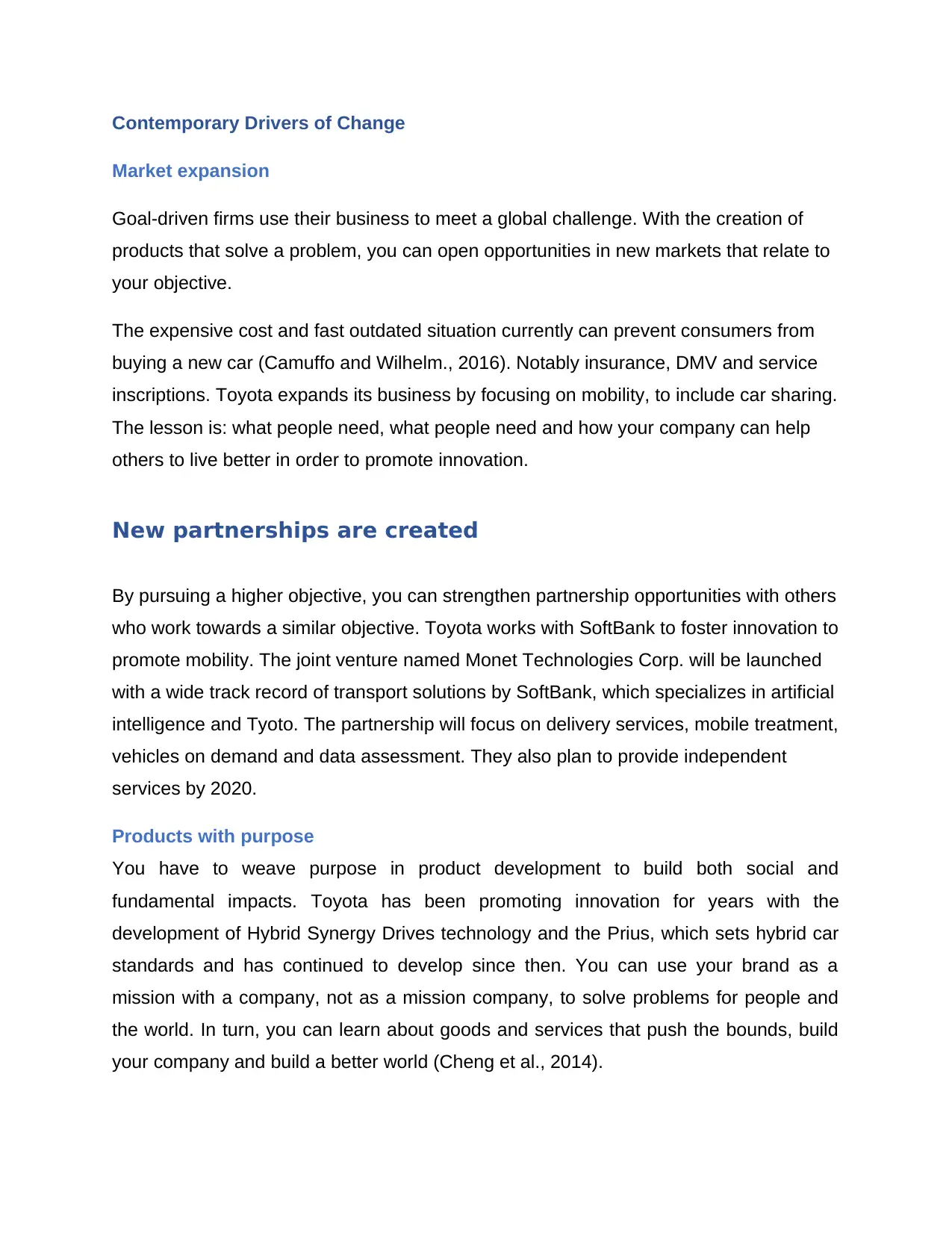
Contemporary Drivers of Change
Market expansion
Goal-driven firms use their business to meet a global challenge. With the creation of
products that solve a problem, you can open opportunities in new markets that relate to
your objective.
The expensive cost and fast outdated situation currently can prevent consumers from
buying a new car (Camuffo and Wilhelm., 2016). Notably insurance, DMV and service
inscriptions. Toyota expands its business by focusing on mobility, to include car sharing.
The lesson is: what people need, what people need and how your company can help
others to live better in order to promote innovation.
New partnerships are created
By pursuing a higher objective, you can strengthen partnership opportunities with others
who work towards a similar objective. Toyota works with SoftBank to foster innovation to
promote mobility. The joint venture named Monet Technologies Corp. will be launched
with a wide track record of transport solutions by SoftBank, which specializes in artificial
intelligence and Tyoto. The partnership will focus on delivery services, mobile treatment,
vehicles on demand and data assessment. They also plan to provide independent
services by 2020.
Products with purpose
You have to weave purpose in product development to build both social and
fundamental impacts. Toyota has been promoting innovation for years with the
development of Hybrid Synergy Drives technology and the Prius, which sets hybrid car
standards and has continued to develop since then. You can use your brand as a
mission with a company, not as a mission company, to solve problems for people and
the world. In turn, you can learn about goods and services that push the bounds, build
your company and build a better world (Cheng et al., 2014).
Market expansion
Goal-driven firms use their business to meet a global challenge. With the creation of
products that solve a problem, you can open opportunities in new markets that relate to
your objective.
The expensive cost and fast outdated situation currently can prevent consumers from
buying a new car (Camuffo and Wilhelm., 2016). Notably insurance, DMV and service
inscriptions. Toyota expands its business by focusing on mobility, to include car sharing.
The lesson is: what people need, what people need and how your company can help
others to live better in order to promote innovation.
New partnerships are created
By pursuing a higher objective, you can strengthen partnership opportunities with others
who work towards a similar objective. Toyota works with SoftBank to foster innovation to
promote mobility. The joint venture named Monet Technologies Corp. will be launched
with a wide track record of transport solutions by SoftBank, which specializes in artificial
intelligence and Tyoto. The partnership will focus on delivery services, mobile treatment,
vehicles on demand and data assessment. They also plan to provide independent
services by 2020.
Products with purpose
You have to weave purpose in product development to build both social and
fundamental impacts. Toyota has been promoting innovation for years with the
development of Hybrid Synergy Drives technology and the Prius, which sets hybrid car
standards and has continued to develop since then. You can use your brand as a
mission with a company, not as a mission company, to solve problems for people and
the world. In turn, you can learn about goods and services that push the bounds, build
your company and build a better world (Cheng et al., 2014).
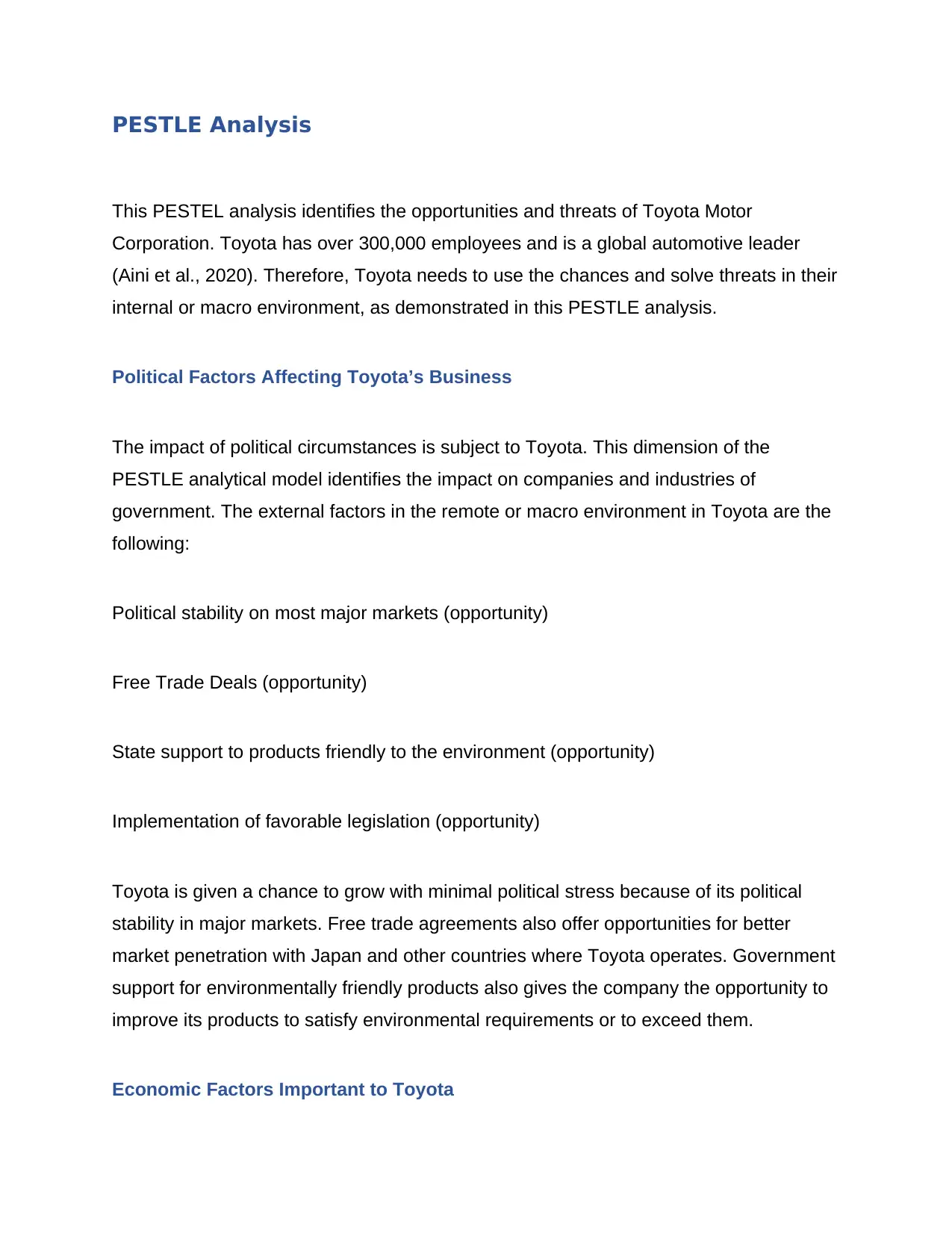
PESTLE Analysis
This PESTEL analysis identifies the opportunities and threats of Toyota Motor
Corporation. Toyota has over 300,000 employees and is a global automotive leader
(Aini et al., 2020). Therefore, Toyota needs to use the chances and solve threats in their
internal or macro environment, as demonstrated in this PESTLE analysis.
Political Factors Affecting Toyota’s Business
The impact of political circumstances is subject to Toyota. This dimension of the
PESTLE analytical model identifies the impact on companies and industries of
government. The external factors in the remote or macro environment in Toyota are the
following:
Political stability on most major markets (opportunity)
Free Trade Deals (opportunity)
State support to products friendly to the environment (opportunity)
Implementation of favorable legislation (opportunity)
Toyota is given a chance to grow with minimal political stress because of its political
stability in major markets. Free trade agreements also offer opportunities for better
market penetration with Japan and other countries where Toyota operates. Government
support for environmentally friendly products also gives the company the opportunity to
improve its products to satisfy environmental requirements or to exceed them.
Economic Factors Important to Toyota
This PESTEL analysis identifies the opportunities and threats of Toyota Motor
Corporation. Toyota has over 300,000 employees and is a global automotive leader
(Aini et al., 2020). Therefore, Toyota needs to use the chances and solve threats in their
internal or macro environment, as demonstrated in this PESTLE analysis.
Political Factors Affecting Toyota’s Business
The impact of political circumstances is subject to Toyota. This dimension of the
PESTLE analytical model identifies the impact on companies and industries of
government. The external factors in the remote or macro environment in Toyota are the
following:
Political stability on most major markets (opportunity)
Free Trade Deals (opportunity)
State support to products friendly to the environment (opportunity)
Implementation of favorable legislation (opportunity)
Toyota is given a chance to grow with minimal political stress because of its political
stability in major markets. Free trade agreements also offer opportunities for better
market penetration with Japan and other countries where Toyota operates. Government
support for environmentally friendly products also gives the company the opportunity to
improve its products to satisfy environmental requirements or to exceed them.
Economic Factors Important to Toyota
⊘ This is a preview!⊘
Do you want full access?
Subscribe today to unlock all pages.

Trusted by 1+ million students worldwide
1 out of 18
Related Documents
Your All-in-One AI-Powered Toolkit for Academic Success.
+13062052269
info@desklib.com
Available 24*7 on WhatsApp / Email
![[object Object]](/_next/static/media/star-bottom.7253800d.svg)
Unlock your academic potential
Copyright © 2020–2025 A2Z Services. All Rights Reserved. Developed and managed by ZUCOL.





